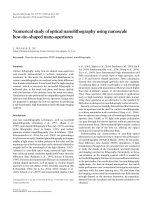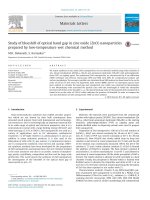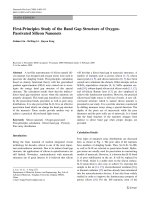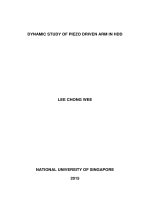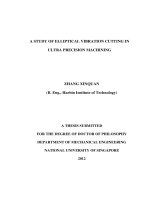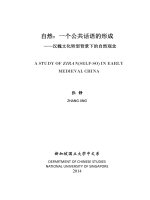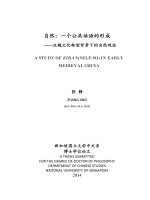study of blueshift of optical band gap in zinc oxide (zno) nanoparticles
Bạn đang xem bản rút gọn của tài liệu. Xem và tải ngay bản đầy đủ của tài liệu tại đây (506.62 KB, 4 trang )
Study of blueshift of optical band gap in zinc oxide (ZnO) nanoparticles
prepared by low-temperature wet chemical method
M.K. Debanath, S. Karmakar
n
Department of Instrumentation & USIC, Gauhati University, Guwahati 781014, India
article info
Article history:
Received 29 July 2013
Accepted 16 August 2013
Available online 24 August 2013
Keywords:
ZnO nanoparticles
Semiconductors
UV–vis absorption
Blueshift
Optical band gap
abstract
We report synthesis of zinc oxide (ZnO) nanoparticles via wet chemical method using molar solutions of
zinc nitrate hexahydrate [Zn(NO
3
)
2
Á 6H
2
O] and ammonium hydroxide (NH
4
OH) with polyvinylpyrolli-
done (PVP) as capping agent. The synthesized ZnO nanoparticles are characterized by X-ray diffraction
(XRD) technique and electron microscopy (TEM and SEM with EDX) for compositional analysis and
surface morphology. The average crystallite size calculated from XRD pattern has been found to be on the
order of 8.5 nm. In this work, the hyperbolic band model (HBM) and UV–vis absorption spectra have
been utilized to calculate the band gap and nanoparticle size which was proposed by Meulenkamp.
It was Meulenkamp who correlated the particle sizes with the wavelength at which the absorption
becomes half of that at the shoulder (λ
1/2
). The optical band gap value of the prepared ZnO nanoparticle is
found to be on the order of 3.63 eV which indicates the presence of blueshift. In order to compare the
size and distribution of ZnO nanoparticles, TEM has been utilized.
& 2013 Elsevier B.V. All rights reserved.
1. Introduction
Nano-semiconductor materials that exhibit peculiar proper-
ties which are not shown by their bulk counterparts have
attracted much interest from both fundamental and technologi-
cal researchers. ZnO is technologically an important material due
to its wide range of optical and electrical properties; also it is a
semiconductor crystal with a large binding energy (60 meV) and
wide band gap (3.3 eV at 30 0 K). ZnO nanoparticles are used in a
variety of applications such as U V absorption, antibacterial
treatment [1], UV light emitter s [2], photocatalyst [3] and as an
additive in many industrial products. It is also used in the
fabrication of solar cells [4], gas sensors [5], luminescent materi-
als [6], transparent conductor, heat mirrors and coatings. Differ-
ent synthesis methods have been developed for the preparation
of ZnO nanoparticles and among these, the wet chemical method
is the most attractive one due to its perfect control of morphol-
ogy, purity, crystallinity, composition and low cost for large-scale
production. This work reports the synthesis of ZnO nanoparticle
for investig ation of the blueshift of the optical band gap of
nanocrystals at pH¼7.5.
2. Experimental
Materials: All materials were purchased from the commercial
market with highest purity (99.99%). Zinc nitrate hexahydrate [Zn
(NO
3
)
2
Á 6H
2
O] and ammonium hydroxide (NH
4
OH) as the starting
materials, polyvinylpyrrolidone (PVP) as capping agent and
double-distilled water as dispersing solvent were used to prepare
ZnO nanoparticle.
Preparation of ZnO nanoparticles: 100 ml of 0.1 mol solution of
Zn(NO
3
)
2
Á 6H
2
O was stirred constantly for 30 min at 60 1C (solu-
tion A). 3 wt% of PVP was stirred constantly at 60 1C for 30 min
(solution B). Now NH
4
OH was slowly added drop by drop into
solution A and stirred at room temperature for 15 min and the pH
of the solution was continuously measured. When the pH of the
solution is 7.5 and a white solution (solution C) of ZnO is formed
the addition of NH
4
OH is stopped. The final mixture (solution B
and solution C) is stirred constantly for 1 h at 60 1C and allowed to
cool down at room temperature till the white precipitate of ZnO is
formed. The whole solution is allowed to settle overnight in a dark
chamber. Finally, the precipitate is filtrated which is washed with
distilled water to dissolve the impurities and dried at 60 1Cinan
oven for 12 h. The basic chemical reaction governing the formation
of ZnO has been reported in our earlier work [7].
Characterization methods: Powder X-ray diffraction(XRD) pat-
tern of prepared ZnO nanoparticle is recorded by a Philips X-ray
Diffractrometer (X'Pert Pro) with Cu K
α1
radiation (λ¼1.5406 Å). A
scanning electron microscope (SEM with EDX, JEOL JSM Model
6390LV) has been used for surface morphology and compositional
Contents lists available at ScienceDirect
journal homepage: www.elsevier.com/locate/matlet
Materials Letters
0167-577X/$ - see front matter & 2013 Elsevier B.V. All rights reserved.
/>n
Corresponding author. Tel.: þ 91 985 998 3361.
E-mail addresses: (M.K. Debanath),
(S. Karmakar).
Materials Letters 111 (2013) 116–119
analysis of the prepared ZnO nanoparticles. The optical absorption
spectra of ZnO dispersed in water are recorded by a UV–vis
spectrometer (HITACHI model U-3210). Transmission electron
microscopy (TEM) observations are carried out on a JEM-100 CX
II electron microscope. The band gap of the ZnO nanoparticle is
calculated from the UV absorption result.
3. Results and discussion
X-ray diffraction analyses: In or der to identify the p hase and t o
know the structure of ZnO nanoparticles, X-r a y diffraction pattern is
recorded in the range of 25–751 (2 θ) a t a scanning rate o f 0.021/s and
1s/step.Fig. 1(a) s how s the p resence of only Z nO phase in the sample
which corresponds to (100), (002), (1 0 1 ), (1 02), (110 ), (1 03), (200),
(112), (20 1), and (004) planes in the hexagonal phase of ZnO with
space grou p P6
3
mc and u nit cell par ameters are a¼b¼3.257 Å and
c¼ 5.213 Å (PDF N o. 79 -0207). T he b roaden ing o f peaks i s obse rved
which is mainly due to the finite size (D) of t he crystallite and some
contribution of strain. T he following procedure is adopted prior to XRD
observation as r eported ear lier [7]:
(1). The diffractometer is calibrated by a standard silicon sample.
(2). Correction of instrumental broadening of β
2θ
arising due to slit
width of the K
α1
and K
α2
lines is also made. The diffraction
broadening only due to grain size β
g
is given by the Warren
rule [8]
β
2
g
¼ β
2
2θ
Àβ
2
where β is FWHM of a line produced under similar geometrical
conditions by the standard material (silicon) with crystallite size
$54 nm. The crystallite size (D) for the chemically prepared ZnO
nanoparticles is then evaluated for the preferred planes (hkl) using
Debye Scherrer's formula [9]
D ¼ Kλ=β
g
cos θ
where λ is the wavelength of radiation used, θ is the Bragg angle
and K¼0.9 for spherical shape. The average crystallite size is found
to be $8.5 nm in the directions perpendicular to (101) and (102)
planes.
XRD is widely used to determine the particle size of nanopar-
ticles but TEM is the best way for the measurement of nanoparticle
size. The Scherrer method for calculating particle size gives an
average value of the entire particle responsible for diffraction.
However, by TEM, besides directly measuring particle size, the
morphology of the particles can also be observed. The typical
HRTEM result in Fig. 1(b) shows almost spherical shapes with
smooth surface. Almost non-dispersed, individual nanoparticles
are identified as bulk dots in the HRTEM micrograph having
average diameter of nanoparticle is$ 6.5 nm. It is to be noted that
the HRTEM photograph pattern is recorded using selected area
observations and the particle size is determined in higher magni-
fication ($ 2 Â 10
5
). The grain boundaries (GBs) of nanograined
ZnO can drastically change the physical properties [10–12].Itis
observed that the ferromagnetism (FM) at room temperature (RT)
of the pure and doped ZnO nanoparticles is because of GBs and
related oxygen vacancies or defects arranged in GBs and the RT
ferromagnetism of the microstructure in ZnO and doped ZnO
depends on the specific grain boundary (GB) area, i.e. the ratio of
GB area to grain volume S
GB
[13]. FM of ZnO is Mn-doped ZnO are
observed only if the grain boundary area in the unit volume of the
material is greater than a certain threshold value S
th
(S
th
¼(773) Â
10
7
m
2
/m
3
for pur e ZnO a nd S
th
¼(274) Â 10
5
m
2
/m
3
for Mn-doped
ZnO) [14].ThusnanograinedZnOisconsideredtobeanimportant
material for applications in solar cells,sensors,photovoltaics,photo-
catalysis and sprint onics [15].
UV–vis characterization:UV–vis spectra are taken from the
colloidal solution of ZnO. The UV absorption spectra in Fig. 2(a)
show broad peak at λ $298.8 nm (4.16 eV) which indicates that the
presence of blueshift is observed with decrease in particle size
with respect to bulk ZnO (λ$376 nm; 3.3 eV) and this could be
attributed to the confinement effects [16]. Fig. 1(a) and Fig. 3
indicate that ZnO nanoparticles are successfully synthesized via
the wet chemical method. The direct band gap of ZnO colloid is
estimated from the graph of hν versus (αhν)
2
through the absorp-
tion coefficient α which is related to the band gap E
g
as (αhν)
2
¼k
(hνÀE
g
), where hν is the incident light energy and k is a constant.
The extrapolation of the straight line in Fig. 2(b) to (αhν)
2
¼0 gives
the value of band gap energy E
g
. The optical band gap (E
g
) is found
to be size dependent and there is an increase in the band gap of
the semiconductor with a decrease in particle size. The optical
band gap value obtained for ZnO nanoparticle at pH¼ 7.5 is
3.63 eV. The dependence of the absorption band gap as shown
in Fig. 2(a) on the size of ZnO nanoparticle is used to determine
25 30 35 40 45 50 55 60 65 70 75
0
20
40
60
80
100
120
140
160
180
200
220
004
201
112
200
103
110
102
101
002
100
Intensity (arb. unit)
2
θ
(degree)
Fig. 1. (a) XRD pattern of ZnO nanoparticles prepared at 60 1C and (b) TEM image
of ZnO nanoparticles.
M.K. Debanath, S. Karmakar / Materials Letters 111 (2013) 116–119 117
the particle size. By considering the strong absorption edge in the
absorption spectra of the sample, average particle size has been
estimated by using the following hyperbolic band model [17]:
R ¼
ffiffiffiffiffiffiffiffiffiffiffiffiffiffiffiffiffiffiffiffiffiffiffiffiffiffiffi
2π
2
h
2
E
gb
m
n
ðE
2
gn
ÀE
2
gb
Þ
v
u
u
t
where R is the radius , m* is the effectiv e mass of the specimen
(m*¼29.15 Â 10
À31
kg for ZnO), E
gb
is bulk band gap, h is Planck's
constant (6.626Â 10
À34
Js)andE
gn
is the b and gap at strong absorp-
tion edge. E
gn
can b e calculated by t he formula E
gn
¼hc/λ
gn
,whereh is
Planck's c onstant, c is the v elocity o f light (3 Â 10
8
ms
À1
)andλ
gn
is
the str ong absorption edg e ($ 298.8 nm) obtained from the a bsorption
spectra as shown in Fig. 2(a). The av erage particle size is calculated and
found to be 6.2 nm .
We have calculated particle size of ZnO nanoparticle from
another method which was proposed by Meulenkamp who
introduced the equation below which correlates the particle sizes
to λ
1/2
[18]. The value (2.247 0.09) nm for the diameter of the ZnO
nanoparticle is calculated from the following equation:
1240=λ
1=2
¼ aþ b=D
2
Àc=D
where a ¼3.301, b¼ 294.0 and c¼À1.09, λ
1/2
(nm) is the wave-
length at which absorption becomes half of that at the shoulder,
and D (Å) is the diameter of the particle. It is observed that there
are discrepancies among the sizes estimated from above men-
tioned methods. To obtain the exact size of the particle using
hyperbolic band model, the particle should be exactly circular in
shape. From the HRTEM image it is observed that the particles are
not exactly circular; hence discrepancies occur.
Particle morphology and elemental study: From the SEM image
in Fig. 3, it has been found that all the capped crystals of the
prepared ZnO nanoparticles are nearly spherical in shape. It is also
observed that the surface of the prepared sample is smooth and
uniform with no cracks on it. The result of EDX analysis of ZnO
nanoparticles indicates that the ZnO nanoparticle contains 100%
ZnO void of template.
4. Conclusions
W e ha ve successfull y s ynthesized ZnO nanoparticles b y a simple
wet c hemical method a t l o w t emper ature. The nanostructure of the
prepared ZnO nanoparticle h as been confirmed using XRD, SEM, U V–
vis absorption a nd TEM m icrograph analyses. XRD r esult shows that
the obtained ZnO nanoparticles are composed of ZnO phase in the
hexag onal s y stem with s pace g r oup P 6
3
mc and unit c ell parameters
are a¼b¼3.257 Å and c¼5.2 13 Å with proper crystallinity. The
av erage cry stallite size obtained b y XRD is $8.5 nm using the Scherrer
formula. The estimated optical b and gap of ZnO i s found to be 3.63 eV
which also clearly indicates the presence of blueshift a t a growth
temperature of 60 1C. The UV abso rpt ion resul t also show s an incr ease
in optical band gap which e xhibits a quantum c onfinement effect.
Acknowledgments
The authors thank the S AIF, Department of Instrumentation & USIC,
Gauhati University; T ezpur University ; SAIF, NEHU Shillong; and
Department of Chemistry, Gauhati University ; for providing XRD,
SEM, TEM and UV–vis spectroscopy measurements respectively .
Fig. 3. SEM image of ZnO nanoparticles and EDX spectra of the prepared ZnO
nanoparticles with composition of elements.
250 260 270 280 290 300 310 320 330 340 350
1.00
1.25
1.50
1.75
2.00
2.25
λ
1/2
Absorption (arb. unit)
Wavelength (nm)
298.8
318.9
2.50 2.75 3.00 3.25 3.50 3.75 4.00 4.25
0
25
40
35
30
20
15
10
(
α
h
ν
)
2
x 10
6
(eV
2
m
-2
)
h
ν
(eV)
5
3.63
Fig. 2. (a) Absorption spectra of ZnO colloid and (b) optical band gap of ZnO colloid.
M.K. Debanath, S. Karmakar / Materials Letters 111 (2013) 116–119118
References
[1] Nawaz HR, Solangi BA, Zehra B, Nadem U. Preparation of nano zinc oxide and
its application in leather as a retaining and antibacterial agent. Canadian
Journal on Scientific and Industrial Research 2011;4:164–70.
[2] Ng HT, Chen B, Li J, Han J, Meyyappan M, Wu J, et al. Optical properties of
single-crystalline, Zno nanowires on M-sapphire. Applied Physics Letters
2003;82:2023–5.
[3] Yadav A, Prasad V, Kathe AA, Raj S, Yadav D, Sundaramoorthy C, et al.
Functional finishing in cotton fabrics using zinc oxide nanoparticles. Bulletin
of Materials Science 2006;29:641–5.
[4] Al-Kahlout A. ZnO nanoparticles and porous coatings for dye-sensitized solar
cell application: photoelectrochemical characterization. Thin Solid Films
2012;520:1814–20.
[5] Zhang Q, Xie C, Zhang S, Wang A, Zhu B, Wang L, et al. Identifi cation and
pattern recognition analysis of chinese liquors by doped nano ZnO gas sensor
array. Sensors and Actuators B 2005;110:370–6.
[6] Zang J, Yu W, Zang L. Fabrication of semiconducting ZnO nanobelts using a
halide source and their photoluminescence properties. Physics Letters A
2002;299:276–81.
[7] Debanath MK, Karmakar S, Borah JP. Structural characterization of Zno
naoparticles synthesized by wet chemical method. Advanced Science, Engi-
neering and Medicine 2012;4:306–11.
[8] Warren BE. X-ray diffraction. London: Addition-Wesley; 1969.
[9] Klug HP, Alexander LE. X-ray diffraction procedures for polycrystalline and
amorphous materials. 2nd ed New York: Wiley; 1954.
[10] Straumal BB, Mazilkin AA, Protasova SG, Myatiev AA, Straumal PB, Schütz G,
et al. Magnetization study of nanograined pure and Mn-doped films:
formation of a ferromagnetic grain-boundary foam. Physical Review B
2009;79:205206 (5).
[11] Straumal B, Mazilkin A, Protasova S, Myatiev A, Straumal P, Goering E, et al.
Influence of texture on the ferromagnetic properties of nanaograined ZnO
films. Physica Status Solidi B 2011;248:1581–6.
[12] Straumal BB, Protasova SG, Mazilkin AA, Tietze T, Goering E, Baretzky B, et al.
Ferromagnetic behavior of Fe-doped ZnO nanograined films. Beilstein Journal
of Nanotechnology 2013;4:361–9.
[13] Straumal BB, Mazilkin AA, Protasova SG, Myatiev AA, Straumal PB, Goering E,
et al. Amorphous grain boundary layers in the ferromagnetic nanaograined
ZnO films. Thin Solid Films 2011;520:1192–4.
[14] Straumal BB, Myatiev AA, Straumal PB, Mazilkin AA, Protasova SG, Schütz G,
et al. Grain boundary layers in nanocrystalline ferromagnetic zinc oxide. JETP
Letters 2010;92:396–
400.
[15] Shabannia R, Abu-Hassan H. Vertically aligned ZnO nanorods synthesized
using chemical bath deposition method on seed- layer ZnO/polyethylene
naphthalate (PEN) substrates. Materials Letters 2013;90:156–8.
[16] Gu Y, Kuskovsky IL, Yin M, O'Brien S, Neumark GF. Quantum confinement in
ZnO nanorods. Applied Physics Letters 2004;85:3834–5.
[17] Nanda JJ, Sarma DD. Photoemission spectroscopy of size selected zinc sul fide
nanocrystallites. Journal of Applied Physics 2001;90:2504–11.
[18] Meulenkamp EA. Synthesis and growth of ZnO nanoparticles. Journal of
Physical Chemistry B 1988;102:5566–72.
M.K. Debanath, S. Karmakar / Materials Letters 111 (2013) 116–119 119

